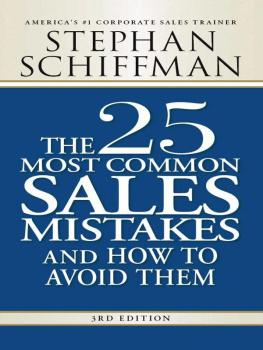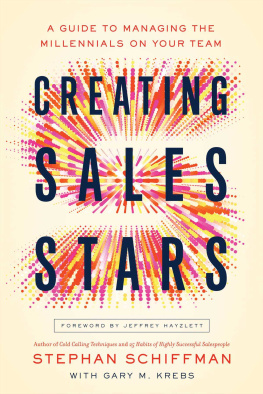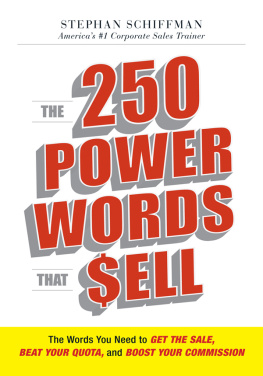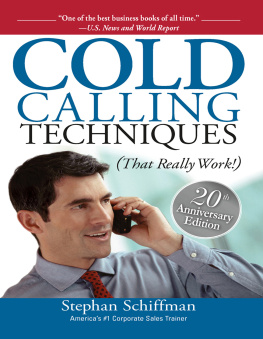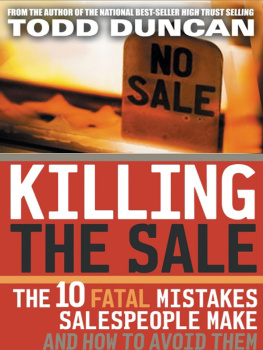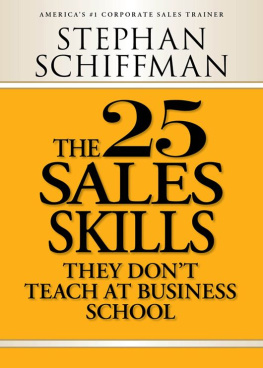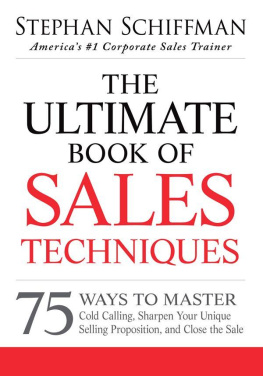THE
MOST COMMON
SALES
MISTAKES
AND HOW TO
AVOID THEM
3RD EDITION
STEPHAN SCHIFFMAN
AMERICAS #1 CORPORATE SALES TRAINER

Copyright 2009, 1997, 1991 by Stephan Schiffman
All rights reserved.
This book, or parts thereof, may not be reproduced in any form without permission from the publisher; exceptions are made for brief excerpts used in published reviews.
Published by
Adams Business, an imprint of Adams Media,
a division of F+W Media,Inc.
57 Littlefield Street, Avon, MA 02322. U.S.A.
www.adamsmedia.com
ISBN 10: 1-59869-821-4
ISBN 13: 978-1-59869-821-3
eISBN: 978-1-44051-389-3
Printed in the United States of America.
J I H G F E D C B A
Library of Congress Cataloging-in-Publication Data
is available from the publisher.
This publication is designed to provide accurate and authoritative information with regard to the subject matter covered. It is sold with the understanding that the publisher is not engaged in rendering legal, accounting, or other professional advice. If legal advice or other expert assistance is required, the services of a competent professional person should be sought.
From a Declaration of Principles jointly adopted by a Committee
of the American Bar Association and a Committee of Publishers and
Associations
Many of the designations used by manufacturers and sellers to distinguish their product are claimed as trademarks. Where those designations appear in this book and Adams Media was aware of a trademark claim, the designations have been printed with initial capital letters.
This book is available at quantity discounts for bulk purchases.
For information, please call 1-800-289-0963.
To your future

Contents
Bonus Mistakes
Acknowledgments
I would like to thank the following people for their help with this book: Anne, Daniele, and Jennifer for their unceasing support.
Introduction to the Third Edition
Once or twice a year Im asked to revise one of my old books. Some might suspect that revisiting old work is boring in a dj vu, been-there-done-that kind of way. On the contrary, I look forward to it.
For one thing, looking back reaffirms the basic tenets of my sales philosophy. I make very few changes of any kind and none of any substantive nature. If these books required substantial revision, it would mean that what Ive been preaching is wrong.
But sometimes there are amusing aspects to my nostalgic trips back in time. For example, somewhere in the middle of a prior edition of this book I suggested it is appropriate to send a thank-you note to a prospect following a first visit, a reminder of what was discussed and that youll be getting back to him shortly. Moreover, I even told you how to prepare the note on a good typewriter.
Can you even find a good typewriter in an office now?
Technological advances aside, the basic to dont list offered here is as valid today as it was when it was first written about a decade and a half ago.
In fact, the rules may be more pertinent today than they were then. As this introduction is being written, the American economy is in terrible shape. Oil prices, which were outrageously high, are lowerbut who knows for how long. Were in the midst of a mortgage crisis. And unemployment is the highest its been in years. Theres even talk that Americas largest auto companies are being driven to bankruptcy.
Hopefully, all that will have changed by the time you read these words. With any degree of luck, well all be back on the road to prosperity. But in an ironic way, I believe these down times are good for us.
When weand by we I mean sales repsgo through a period of prosperity, we tend to get sloppy. Orders come in so easilywhether we do things correctly or notthat we forget the basics. Bad times serve as a wake-up call, a reminder that if we continue to make silly (okay, stupid) errors, someone else will get the business.
The original version of this book included twenty-five common sales mistakesand how to avoid them. Ive added five new mistakesreflecting patterns of errors Ive noticed in classes over the last few years.
Finally, Ive always been a little leery of part of this books title: 25 Most Common Sales Mistakes blaring across the cover struck me as a little negative. I always suspected that that was all potential readers ever saw. People never like to be told that theyre doing something incorrectly. I understand that. Thats why I think its important to focus on the other part of the titlehow to avoid them, how to stay on track, how to close sales in any environment.
I think youll enjoy this book. More important, I think youll profit from it. And if you have any suggestions, feel free to contact me in care of sschiffman@steveschiffman.com.
I answer all correspondence. Especially the letters from people who enjoyed the book.
Stephan Schiffman
February 2009
New York City
Introduction
This book is not a cure-all; it doesnt promise an instant turnaround to your sales career. My feeling is that, without your efforts and commitment to your own results, no book can do that.
This book can, however, be used as an effective tool for identifying and resolving the most common and troublesome sales mistakesthe ones that needlessly eat away at commission dollars. If thats a topic of concern to you, read on.
If youve ever watched the summer Olympic swimming competitions, youve no doubt noticed that the winners of these races tend to win by very slim marginstenths or hundredths of a second. Thats remarkable, isnt it? That when the top athletes in the field come together, the amount of time separating them at the finish line is often about as much time as it takes to snap your fingers?
I think sales is sometimes very similar. The competition out there can be brutal; victories are often decided by hairbreadth margins. Lose three or four important hairbreadth races in a row, and youre out of business; win three or four, and youre tops in your field.
Thats where this book comes in. The solutions Ive offered to the most common sales mistakes are designed to help you add to your personal sales efficiencya little bit here, a little bit there. Im not out to reinvent the wheel with this book, but rather to give you enough of an edge in enough common problem areas to make victory more likely for you in a tough race. The book is designed to be read easily and quickly. You wont find long discourses on psychology or personal interaction here, but rather tangible ideas you can put into practice immediately.
My favorite kind of sales book is one you can read in a day or two and get impressive results from immediately. I believe this is that kind of book, and I think you will too.
Let me know if you agree. Write to me about this book and how it works for you. Heres my address:
Stephan Schiffman
c/o Adams Media/Publishers
57LittlefieldStreet
Avon, MA 02322 USA
Good luck!
MISTAKE #1
Not Being Obsessed
You must like what you are doing for a livingselling enough to become obsessed with it. Not fifteen-hours-a-day obsessed, but rather I-have-absolutely-got-to-do-this-right-day-in-and-day-out obsessed.
For my money, the most crucial word in sales today is obsession; close behind it are two supporting ideas, utilization and implementation. Lets talk a little bit about what these three words really mean for you.
Obsession
Every day, I make twenty cold calls. And by making twenty cold calls, I can get through to maybe seven people. Once I get through to seven people, Ill usually set up one appointment. I do that five days a week, which, by extension, means that every week, I have, on average, five new sales appointments. I close one out of five, so at the end of the year, I should have fifty new customers.
Next page
